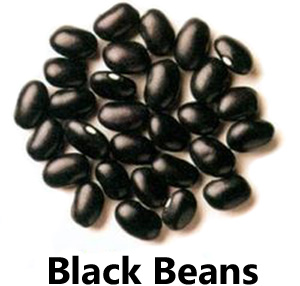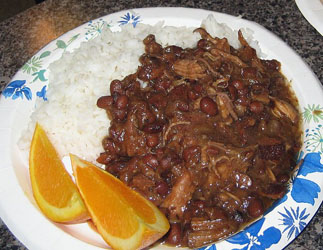Black Beans Nutrition facts
Black beans, characterized by their small size and deep black skin, belong to the legume family Fabaceae. They are a staple ingredient in traditional Latin American, Caribbean, and Southwestern (U.S.) dishes.
Taxonomically, black beans are part of the common bean family (Fabaceae), specifically in the genus Vicia, with the scientific name Phaseolus vulgaris.
They are also known by various synonyms including Turtle beans, caviar criollo, and frijoles negros.
 |
Black beans are an annual dicotyledonous field crop, although there are varieties of pole black beans cultivated in home gardens. Thriving in fertile-rich, sandy soils, this crop produces pink, lilac, or purple flowers in cymes approximately 60-65 days after seedling. These flowers give way to long, cylindrical pods containing 4-8 medium-sized, ovate, jet-black seeds with tiny white eyes.
When cooked, the beans lose their original color, transforming into a deep purple hue. Boiled black beans offer a mild, sweet flavor with a creamy texture. Mature beans intended for fresh consumption are typically harvested just before reaching the dried stage.
Health Benefits of Black Beans
Black beans stand out as one of the top vegetarian protein sources. In a 100-gram (3.5 oz) serving, they pack 341 calories and provide a significant 21.60 grams or 38% of the recommended daily intake of protein.
These beans are also noteworthy for their moderate levels of antioxidant anthocyanidin compounds such as Delphinidin and Malvidin, which contribute to their characteristic black to deep purple pigment.
Furthermore, black beans are rich in petunidin, an O-methylated anthocyanidin known for its antioxidant properties. With 0.15 mg of petunidin per 100 grams, these beans contain a natural, water-soluble pigment that lends them their dark-red to purple hue.
Similar to other legumes, black beans boast ample dietary fiber, offering 15.5 grams or 41% of fiber per 100 grams. This fiber acts as a bulk laxative, safeguarding the colon mucosa by reducing exposure to harmful substances and binding to potential carcinogens.
Studies have shown that dietary fiber can lower blood cholesterol levels by impeding the reabsorption of cholesterol-binding bile acids in the colon.
Black beans serve as gluten-free protein sources, making them suitable alternatives for individuals with gluten sensitivity or celiac disease.
Moreover, black beans rank among the top sources of various B-complex vitamins, including folates, thiamin, pyridoxine, pantothenic acid, riboflavin, and niacin. These vitamins act as co-factors for enzymes involved in carbohydrate, protein, and fat metabolism.
Notably, black beans are exceptionally rich in folates, providing 444 μg or 111% of the daily recommended intake. Folate, alongside vitamin B-12, plays a crucial role in DNA synthesis and cell division, potentially reducing the risk of neural tube defects during pregnancy.
Furthermore, black beans are a significant source of minerals, with 100 grams of dry beans containing 93% of the daily recommended intake of copper, 63% of iron, 46% of manganese, 50% of phosphorus, 12% of calcium, and 33% of zinc.
A 100-gram serving of black beans provides 1483 mg or 31.5% of the recommended intake of potassium. Potassium plays a crucial role as an electrolyte in cellular and fluid balance, counteracting the adverse effects of sodium on heart health and blood pressure.
According to the U.S. Government Dietary Guidelines-2005, adults are advised to consume three cups of cooked dry beans per week.
| Principle | Nutrient Value | Percent of RDA |
|---|---|---|
| Energy | 341 Kcal | 17% |
| Carbohydrates | 62.36 g | 48% |
| Protein | 21.60 g | 38.57% |
| Total Fat | 1.42 g | 7% |
| Cholesterol | 0 mg | 0% |
| Dietary Fiber | 15.5 g | 41% |
| Vitamins | ||
| Folates | 444 μg | 111% |
| Niacin | 1.955 mg | 12% |
| Pantothenic acid | 0.899 mg | 18% |
| Pyridoxine | 0.286 mg | 22% |
| Riboflavin | 0.193 mg | 15% |
| Thiamin | 0.900 mg | 75% |
| Vitamin-C | 0 mg | 0% |
| Electrolytes | ||
| Sodium | 5 mg | <1% |
| Potassium | 1483 mg | 31.5% |
| Minerals | ||
| Calcium | 123 mg | 12% |
| Copper | 0.841 μg | 93% |
| Iron | 5.02 mg | 63% |
| Magnesium | 171 mg | 43% |
| Manganese | 1.060 mg | 46% |
| Phosphorus | 352 mg | 50% |
| Selenium | 3.2 μg | 6% |
| Zinc | 3.65 mg | 33% |
| Phyto-nutrients | ||
| Isoflavones | 0 mg | |
| Petunidin | 15.4 mg | |
| Delphinidin | 18.5 mg | |
| Malvidin | 10.6 mg |
Choosing and Storing Black Beans
Black beans are a staple in North and South American cuisines, particularly among Latin American communities. They are available in dry form in air-sealed packets or canned for immediate or short-term use, typically found year-round in supermarkets.
To maintain their quality, store dry black beans in a cool, dry place away from direct sunlight, humidity, and excessive moisture, where they can keep well for several months.
During summer and early fall, some farmers' markets offer fresh "black shelling beans," which can be used similarly to lima or fava beans. These cook quickly and don't require soaking.
When using fresh black shelling beans, treat them like other shelled beans. For the best flavor, shell and use them within three to four days.
Occasionally, home gardeners utilize fresh, unripe whole bean pods in a manner akin to green beans.
Preparation and serving methods
Black beans hold a cherished place among dry beans in the Southern regions of the United States, Mexico, and Brazil.
Typically, cooking black beans involves soaking them in cold water for 5-8 hours. Compared to many other types of dry beans, black beans require a longer cooking time. Alternatively, they can be simmered for approximately 1 hour or pressure cooked for 35 minutes after soaking. Soaking and boiling also aid in removing anti-nutritional compounds and minimizing flatulence.
 |
| Feijoada-national dish of Brazil. Photo credit: sylvie szafranski |
Here are some serving tips:
Black beans are prominently featured in the Cajun and Creole cuisine of the Southern states.
Frijoles negros refritos (Refried black beans) constitute a staple in Mexican and Southwestern cooking. Boiled beans are sautéed in a pan with added oil, onion, and spice powder, then mashed using a potato masher. Garnish with cilantro and green onions, and serve as a dip with burritos or tortillas.
Black beans are also utilized in baked bean recipes, often with bacon in a molasses-based sauce, resembling the preparation of kidney, cannellini, and navy beans.
Shelled and boiled black beans are incorporated into bean salads, flavorful soups, and stews, combined with complementary herbs, spices, and vegetables.
Feijoada, Brazil's national dish, consists of black beans cooked with a variety of salted pork or beef and served with rice. Orange slices are often served alongside to enhance iron absorption.
Black bean casserole is a traditional Mexican dish, popular in Southwestern states and Mexico.
In the Maharashtra state of India, black beans, known as kala ghevada (काळा घेवडा), are used in the preparation of kala ghevadyachi usal (काळा घेवड्याची उसळ).
Safety profile
It's important to thoroughly cook black beans before consumption. Similar to other dry kidney beans, eating uncooked or undercooked black beans can lead to poisoning from phyto-hemagglutinin (lectin) toxin. This condition may result in the clumping of red blood cells in humans, along with symptoms such as nausea, vomiting, and diarrhea. Using a pressure cooker effectively neutralizes these compounds, rendering the beans safe for consumption. (Medical disclaimer).
You may also like to read:-
Adzuki beans Nutrition facts and health benefits.
Chickpeas Nutrition facts and health benefits.
Navy beans Nutrition facts and health benefits.
fava beans Nutrition facts and health benefits.
≻≻-Back to Legumes from Black Beans nutrition. Visit here for an impressive list of vegetables with complete illustrations of their nutrition facts and health benefits.
≻≻-Back to Home page.
Further Reading:
Fieldbean- Horticulture Purdue University.
Alternative Crop Guide-DRY EDIBLE BEANS.